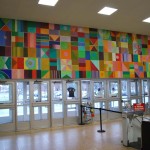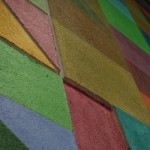

Mario Merola was born in 1931 and attended the École des beaux-arts de Montréal from 1946 to 1952, where he studied decoration with painter Maurice Raymond. In 1952, he went to France to take a set design course at the École supérieure des arts décoratifs de Paris. He then attended the Place des arts encounter workshop, after which he was hired as a costume designer at Radio-Canada. Starting in 1957, Merola produced numerous murals integrated with architecture, including one in the Canadian pavilion at the Brussels World Fair and those in the Sherbrooke and Charlevoix Métro stations, as well as fighting for professional recognition of artists.

Artwork description
La joie is an abstract mural installed above the doors to the main entrance of Centre Pierre-Charbonneau.
This monumental-size polychrome mural made of acrylic paint on concrete is composed of simple geometric forms. Colour, an important element in Merola’s murals, is an essential aspect of the composition of this artwork, which vibrates to the rhythms of the juxtaposed shapes. Although there is no depth of field, a detailed analysis of the artwork reveals some modelling that accentuates the vibrating effect of the whole. Merola thus integrates a sculptural dimension that brings the work into the tradition of the bas-relief, a tradition updated by the modernist aesthetic of geometric abstraction.
As art historian Danielle Doucet notes, the artwork is one in a series of six murals (produced in 1960 and 1961) in which the artist was experimenting with applying acrylic paint to concrete and plaster. In addition to the one at Centre Pierre-Charbonneau, these works are in the Louis-Hippolyte-Lafontaine school in Boucherville, the Marie-Victorin school in Varennes, the Saint-Vincent school in Saint-Césaire, a school in Otterburn Park, and the Greenfield Park city hall.
(Source: Danielle Doucet, “Art public moderne au Québec sous Maurice Duplessis: Les œuvres murales non commémoratives,” Journal of Canadian Art History/Annales d’histoire de l’art canadien, vol. 10, no. 2 (1998): 67.)



